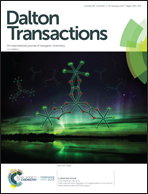A calix[4]arene-modified (Pc)Eu(Pc)Eu[T(C4A)PP]-based sensor for highly sensitive and specific host–guest electrochemical recognition†
Abstract
A calix[4]arene (C4A)-functionalized (phthalocyaninato)(porphyrinato) europium(III) triple-decker compound (Pc)Eu(Pc)Eu[T(C4A)PP] (1) is firstly designed, synthesized and prepared into well-organized films using a simple solution-processing quasi-Langmuir-Shäfer (QLS) method. The QLS film of 1 on an ITO (film 1/ITO) electrode, serving as a host–guest electrochemical recognition layer, is able to establish specific responses/interactions toward organic molecules with biological and drug interest including dopamine (DA), uric acid (UA), tyrosine (Tyr), tryptophan (Trp) and Acetaminophen (APAP), depending mainly on the matching degree of molecular dimensions between the analytes and the C4A cavity in addition to their chemical nature. More significantly, the film 1/ITO electrode shows a wide linear range of electrochemical detection (from 0.1 to 100 μM) to DA and APAP, with a high sensitivity of 53.0 and 94.3 μA mM−1 and a very low detection limit of 25 and 11 nM for DA and APAP, respectively, representing the best result among the nonenzymatic organic semiconductor-based biosensors. In particular, the film 1/ITO electrode exhibits excellent stability, reproducibility, high selectivity, and anti-interference nature for the detection of both DA and APAP, indicating the great potential of calix[n]arene macrocycle-modified tetrapyrrole rare earth sandwich compounds in the field of ultrasensitive and specific nonenzymatic sensors.
![Graphical abstract: A calix[4]arene-modified (Pc)Eu(Pc)Eu[T(C4A)PP]-based sensor for highly sensitive and specific host–guest electrochemical recognition](/en/Image/Get?imageInfo.ImageType=GA&imageInfo.ImageIdentifier.ManuscriptID=C8DT03530J&imageInfo.ImageIdentifier.Year=2019)


 Please wait while we load your content...
Please wait while we load your content...